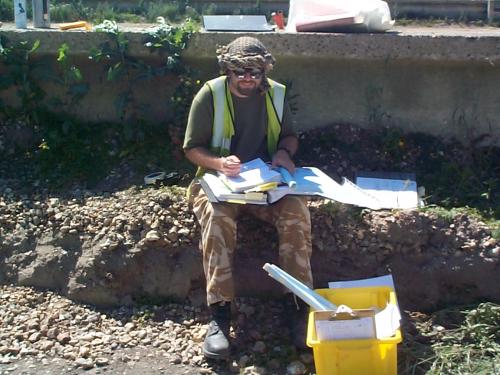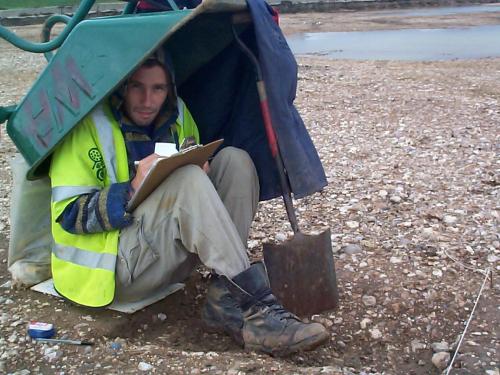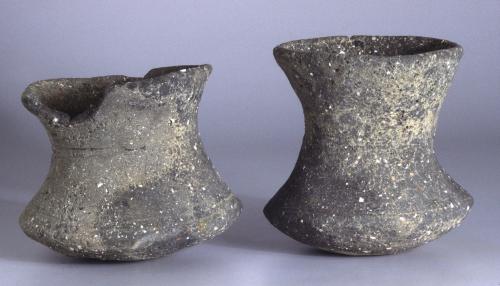- This website reflects our views on the Terminal 5 site based on many years of post-excavation analysis, which culminated in the publication of the final volume of the T5 report in 2010.
The Heathrow Landscape
How do we know this?
Find out more details in our archaeological evidence sectionHeathrow Airport
The Archaeologists
Framework Archaeology
Category Archives: Excavation
Memories of Perry Oaks
Nick Cooke (Project Officer at Heathrow 1998 – 1999)
There were a lot of unknowns when I first started working at Heathrow. It was the first time Wessex Archaeology and Oxford Archaeology had worked on a joint venture in the field, the recording system was entirely new and relied heavily on bespoke technology which had not been trialled in the field on such a scale. Initially we didn’t even know whether any archaeology would have survived the damage caused by the sludge beds of the sewage works.
I arrived on the site in the autumn of 1998 in charge of a small team whose job it was to find out whether any archaeology had survived. This involved watching mechanical diggers remove the remains of the treated sewage from the sludge beds. Pretty soon, it was clear that substantial quantities of archaeology lay beneath the sewage, and a winter of standing ankle deep in ‘cake’, as it was euphemistically called, lay ahead of us. Our small team began the task of surveying the extents of the archaeological features using Total Stations (although an attempt at using a robotic total station was abandoned after we found that it tended to track passing jumbo jets rather than the staff held by the surveyor!). By the end of the winter we had cleared over 20 hectares of land and surveyed the archaeological features in great detail. Despite several washes, I was unable to remove the smell of sewage and aircraft fumes from my working clothes, and had to throw them away.
We started the excavation proper early the following spring. The core team of supervisors, finds and environmental specialists and computer officers were on site early, setting up the offices (no mean feat when dealing with a team of over 70) and making all the necessary preparations. Time was well spent in team building and trialling the new recording system before the massive influx of diggers arrived. There was much emphasis on training the site staff in the early days, both in how to use the recording system and in how the on-site database and GIS system worked. One of the main aims of the recording system was to place much greater emphasis on the diggers to interpret the archaeology as well as record it objectively, and they embraced the opportunity enthusiastically.
The excavations lasted for nearly seven months and involved over 100 staff. Even small tasks which you take for granted on a small project became issues which needed addressing. We had to find accommodation for all of the staff, and provide transport to and from site – no mean feat in West London. Fortunately the team of project officers and supervisors coped magnificently, and all went well. We excavated a huge number of archaeological features, and found some lovely artefacts. Features ranging from Neolithic cursus and henge monuments to a post-medieval canal were carefully dug and recorded, whilst the nicer finds included polished Neolithic stone axes, a superb assemblage of worked wood from Middle Bronze Age waterholes, a pair of lovely carinated Late Bronze Age/Early Iron Age pots, and a hacked up piece of a lead tank or font from a late Roman pit. The combination of the new recording system and the use of on-site databases and GIS went very well, and we produced an unparalleled digital and paper archive of which everyone involved can be rightly proud.
When I look back on it now, though, it is the people who worked there who stay longest in my memory – for their hard work, professionalism and skill, but also for their laughter, sorrow, stubbornness, kindness, stroppiness, helpfulness and occasionally their sheer lunacy. You cannot work on a site for so long with so many people, sharing not only their working day but also their evenings and social lives without forging strong bonds. So when I look back, I also remember the barbecues, the solar eclipse, the parties (one a memorable night on a boat on the River Thames), the arguments, the mad games of park football, and the friendships that were formed. When I look back now at the thousands of photos we took during the course of the project, it is the faces I find myself looking for, and the people that I remember. The archaeologist in me will always remember the excavations and the finds, but it was the people with whom I worked who made it special.
Favourite photos
Rich Connolly, one of the supervisors, checking context sheets. We had a great team of supervisors, all in charge of small teams. Here you can see the tools of his trade – the box full of recording equipment, rolled up hand drawings and folders of completed context sheets. In the summer, the heat was a real problem, with Heathrow consistently amongst the hottest places in the country, hence the head gear, the sun lotion and the water bottle.
Steve Leech, one of the diggers taking shelter from inclement weather whilst recording a feature. Work continued in pretty much all weathers, although severe rain did on occasion cause the site to flood completely
Late Bronze Age/Early Iron Age beakers. These were found placed at the bottom of a waterhole with a larger pot, presumably as part of an offering. I find them such tactile and stylish objects. They are also incredibly unusual – only one other similar vessel has been found from the River Thames. They date to the Late Bronze Age/Early Iron Age transition.
John Lewis on the moment he realised the Stanwell cursus was a political statement
Everyone’s invited to the Neolithic party
On a personal level, my most enduring feeling is one of gratitude for the hard work of so many people over such a long time on this project. Hundreds of archaeologists have now worked on the various elements of the T5 project, and they have all contributed to producing a level of understanding of the history of the Heathrow area that I could only dream about when I started my archaeological career in west London in 1984. I also have to say that the BAA team and their archaeological consultants, Gill Andrews and Professor John Barrett have played a huge part in shaping not only the project but also the ethos of Framework Archaeology.
In archaeological terms, my favourite discovery was working out what the Stanwell cursus near Heathrow actually looked like in the Neolithic period – and what this meant about the nature of society in the area.
The discovery came about during rescue excavations on Thames Water’s sludge works at Perry Oaks. This charming spot was where London’s processed sewage has been pumped since the 1930s onto vast gravel beds to dry before being turned into organic agricultural fertiliser. New technology has now condensed that operation, so most of the site was being cleared.
Initially I worked as a project manager for MoLAS (the Museum of London Archaeology Service) during the first season’s excavations in 1996, and later came back to dig the site more thoroughly for Framework Archaeology in 1998-99. It was a colossal site, of which we excavated about 60 acres (25 ha) during this phase. Just walking around the site took most of the day. We also had to shout a lot because of the Heathrow aircraft constantly flying overhead.
Ancient landscape
But it was an amazing excavation because beneath all these acres of drying beds we found a fantastic landscape dating from the Mesolithic through to the end of the Roman period. But the major monument was the Stanwell cursus, which is at least 2.5 miles long and is the second longest in the country (after the Dorset cursus). The site had been known for some time from aerial photographs and earlier excavations. On our site it appeared as two parallel ditch-lines in the ground.
However the ditches were only about 22m apart – making it about three or four times narrower than a normal cursus. So what did it look like originally, and how was it used? Did it have the normal pair of banks flanking a processional pathway, or was it just a single bank between the two ditches?
I had the plan of the cursus on my wall, showing how it was crossed by a network of Bronze Age field ditches. And as I stared at it, and thought about it, I noticed that one of these ditches narrowed as it began to cross the cursus, and opened out again when it emerged from the other side, in a sort of ‘hourglass’ shape. This was really puzzling until I suddenly realised that the Bronze Age farmers in 1500 BC must have dug their ditch right over the top of the still-existing cursus bank.
Although they maintained the relative depth of their ditch, it didn’t penetrate as deeply into the ground as it crossed the bank. Later, as we looked at other Bronze Age ditches crossing the cursus we found the same ‘hourglass’ pattern again and again. The result of all this was to show that the cursus had always been a single, banked-up pathway between ditches – in other words not really a cursus at all, more a ceremonial causeway or dyke.
I was really excited about this because of what it suggested about Neolithic society in the area. Generally cursuses are interpreted as formalised ceremonial paths from one important place to another. Before they were built, the processions took place on an ordinary pathway, with whole communities able to take part – perhaps meeting at certain points, singing, dancing, drinking, breaking a few pieces of pottery, or knapping a piece of flint.
Exclusive ceremonies
Then as time went on the ceremonies became more exclusive. Typical cursuses, like the Dorset cursus in Wessex, were built on the route of the ceremonial path with high flanking banks to prevent outsiders seeing what was going on within. In many areas, this social stratification increased in the Bronze Age with the elite buried in single tombs with all their finery.
But the west London area seems to be different. There were ceremonial processions in the landscape, and one of these pathways was formalised into the Stanwell cursus. But instead of two flanking ditches you have a raised path. Instead of secret ceremonies, you have processions that were designed to be seen. Then in the Bronze Age, there is no sign of the social differentiation that you get in Wessex. There are no large henges, and virtually no rich burials. It all fits together. The Early Bronze Age of the west London area was not occupied by an overtly stratified and exclusive society – and I believe this reflects the sort of community that a few hundred years earlier built the Stanwell cursus with its ‘socially inclusive’ raised central bank.
Adapted from an article first published in issue 65 of British Archaeology Magazine in June 2003



